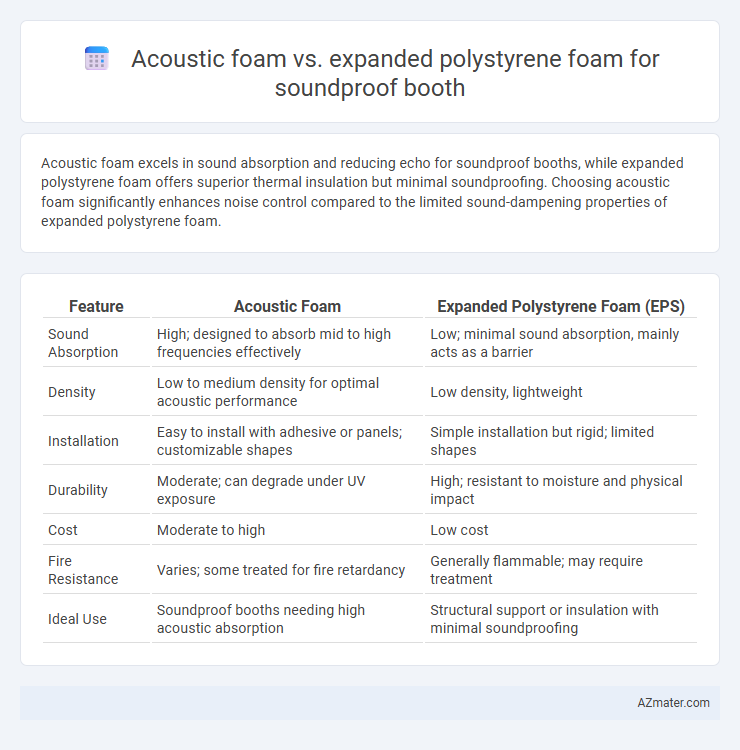Acoustic foam excels in sound absorption and reducing echo for soundproof booths, while expanded polystyrene foam offers superior thermal insulation but minimal soundproofing. Choosing acoustic foam significantly enhances noise control compared to the limited sound-dampening properties of expanded polystyrene foam.
Table of Comparison
| Feature | Acoustic Foam | Expanded Polystyrene Foam (EPS) |
|---|---|---|
| Sound Absorption | High; designed to absorb mid to high frequencies effectively | Low; minimal sound absorption, mainly acts as a barrier |
| Density | Low to medium density for optimal acoustic performance | Low density, lightweight |
| Installation | Easy to install with adhesive or panels; customizable shapes | Simple installation but rigid; limited shapes |
| Durability | Moderate; can degrade under UV exposure | High; resistant to moisture and physical impact |
| Cost | Moderate to high | Low cost |
| Fire Resistance | Varies; some treated for fire retardancy | Generally flammable; may require treatment |
| Ideal Use | Soundproof booths needing high acoustic absorption | Structural support or insulation with minimal soundproofing |
Introduction: Acoustic Foam vs Expanded Polystyrene Foam
Acoustic foam provides superior sound absorption with its open-cell structure designed to reduce echo and reverberation, making it ideal for soundproof booths. Expanded polystyrene foam, while lightweight and cost-effective, primarily offers thermal insulation and limited acoustic performance due to its closed-cell composition. Choosing between these materials depends on the specific soundproofing needs, with acoustic foam delivering better acoustic dampening in professional or home studio environments.
Understanding Acoustic Foam: Material and Properties
Acoustic foam, typically composed of polyurethane or melamine, features an open-cell structure designed to absorb sound waves by converting acoustic energy into heat, effectively reducing reverberation and echo within soundproof booths. Expanded polystyrene (EPS) foam, in contrast, is a closed-cell material primarily used for thermal insulation and offers limited sound absorption due to its rigid, dense structure that reflects rather than dissipates sound. Understanding these material properties highlights that acoustic foam is preferred for soundproof booths because of its superior sound absorption capabilities, whereas expanded polystyrene serves better in applications requiring insulation rather than acoustic control.
What is Expanded Polystyrene Foam (EPS)?
Expanded Polystyrene Foam (EPS) is a lightweight, rigid, closed-cell insulation material made from expanded plastic beads fused together. EPS offers excellent thermal insulation and moisture resistance but provides limited sound absorption compared to acoustic foam. Its rigid structure and low density make it less effective for controlling sound reflections and echoes in soundproof booths, where acoustic foam's porous, open-cell design excels.
Sound Absorption Capabilities Compared
Acoustic foam excels in sound absorption due to its open-cell structure that effectively traps and dissipates mid to high-frequency sound waves, making it ideal for soundproof booths. Expanded polystyrene foam, with its closed-cell composition, provides limited sound absorption and primarily acts as a thermal insulator rather than an effective acoustic treatment. For optimal soundproofing performance, acoustic foam outperforms expanded polystyrene in reducing echoes and reverberations within enclosed spaces.
Noise Isolation Performance: Which Material Wins?
Acoustic foam excels in noise isolation performance for soundproof booths due to its open-cell structure that effectively absorbs mid to high-frequency sound waves, reducing echo and reverberation. Expanded polystyrene foam, with its closed-cell design, primarily offers thermal insulation and less effective noise absorption, making it inferior for isolating sound. Therefore, acoustic foam is the preferred material for optimal noise isolation in soundproof booth construction.
Installation Process and Flexibility
Acoustic foam installs with ease due to its lightweight, adhesive-backed panels, allowing for quick mounting on walls and ceilings without specialized tools, enhancing flexibility in booth design and modifications. Expanded polystyrene foam requires precise cutting and securing, often needing frames or fasteners, which can complicate installation and reduce adaptability for future layout changes. Acoustic foam's pliable nature provides superior customization for irregular spaces, while expanded polystyrene's rigid structure limits adjustability but offers durable insulation.
Durability and Maintenance Factors
Acoustic foam offers superior durability due to its open-cell structure that resists crumbling and maintains shape over time, making it ideal for long-term soundproof booths. Expanded polystyrene foam, while cost-effective, tends to degrade faster and is prone to cracking or breaking under stress, requiring more frequent replacement or repairs. Maintenance for acoustic foam is simpler, as it repels dust and can be lightly vacuumed, whereas expanded polystyrene foam absorbs dirt and moisture, complicating upkeep and reducing longevity.
Cost Comparison: Acoustic Foam vs EPS
Acoustic foam typically costs between $30 and $50 per panel (12" x 12" x 2"), while expanded polystyrene (EPS) foam sheets range from $15 to $30 for similar dimensions, making EPS more budget-friendly for large-scale installations. The higher price of acoustic foam results from its superior sound absorption properties and fire-retardant materials specifically designed for soundproof booths. Despite the initial cost difference, acoustic foam offers better long-term value through enhanced noise reduction efficiency and durability.
Safety and Environmental Considerations
Acoustic foam, typically made from polyurethane or melamine, offers superior fire resistance compared to expanded polystyrene (EPS) foam, which is highly flammable and can release toxic fumes when burned, posing significant safety hazards in soundproof booths. Environmentally, acoustic foam incorporates more sustainable materials and often contains fewer harmful chemicals, whereas EPS foam, although lightweight and cost-effective, is non-biodegradable and contributes heavily to plastic pollution. Choosing acoustic foam enhances safety compliance with fire codes and reduces environmental impact, making it a preferable option for eco-conscious soundproof booth construction.
Best Choice for Soundproof Booths: Final Recommendations
Acoustic foam outperforms expanded polystyrene foam in soundproof booths due to its superior sound absorption coefficients and ability to reduce mid to high-frequency noise effectively. Expanded polystyrene foam offers minimal sound insulation benefits and is primarily suited for thermal insulation rather than acoustic control. For optimal soundproof booth performance, high-density acoustic foam with an NRC rating above 0.75 is the best choice to ensure significant noise reduction and echo control.

Infographic: Acoustic foam vs Expanded polystyrene foam for Soundproof booth
 azmater.com
azmater.com